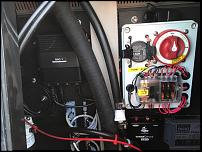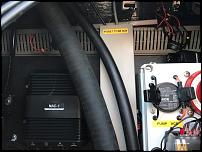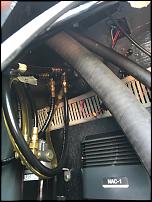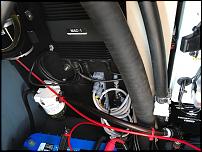 |
|
 26 June 2017, 22:04
26 June 2017, 22:04
|
#1
|
|
Member
Join Date: Oct 2007
Posts: 16
|
Electronics on RHIBS - How does the RNLI do it?
We constantly have issues with electronics (and electricity in general) on our RHIBS.
The devices never survive more than a few seasons. Now, thanks to this forum, I found Neptune waterproof, who make electronic boxes watertight.
However, I am also worried about the installation as such. When looking into brand-new boats from well-known suppliers, I find "open" electrical installations just inside the console, not waterproofed or protected from corrosive seawater at all. And of course, there is always a high degree of humidity in our consoles.
Even if I look at the stuff from companies like Blue Sea Systems, their watertight switchboards are nice on the top side, but the back side is pretty open and unprotected from corrosion.
On another brand-new boat, the electronics failed because the connectors on the inside of the console jumped out of the meter in a wave.
Now I am in charge of redoing the electrical and electronically connection of one of our RHIBS, and honestly, I would prefer to put all electronics and electrical distribution etc. into proper watertight switch cabinets and then fill up these cabinets with resine to the top.
This should leave all corrosive stuff outside, and it should also avoid mechanical failure due to shock etc.
Has anyone ever done this on a RHIB and useful comments on their learnings? Or does anyone know how the RNLI (or similar) solve this issue?
__________________
|

|

|
 27 June 2017, 07:43
27 June 2017, 07:43
|
#2
|
|
Member
Country: UK - Scotland
Town: Denny
Boat name: Highland Bluewater
Length: 6m +
Join Date: Mar 2013
Posts: 1,647
|
Quote:
Originally Posted by solarwarrior

I would prefer to put all electronics and electrical distribution etc. into proper watertight switch cabinets and then fill up these cabinets with resine to the top.
This should leave all corrosive stuff outside, and it should also avoid mechanical failure due to shock etc.
|
Make it a bit hard for fault finding and repair if you did have a problem.
The "mechanical failure" is an issue but I've often seen setups where the weight of the harnesses is being supported by the electrical connectors, decent fixing of the harness will go a long way to prevent failure. 
__________________
|

|

|
 27 June 2017, 07:54
27 June 2017, 07:54
|
#3
|
|
Member
Country: UK - England
Town: South Yorks
Boat name: Black Pig
Make: Ribcraft
Length: 5m +
Engine: DF140a
MMSI: 235111389
Join Date: Feb 2008
Posts: 11,893
|
Electronics on RHIBS - How does the RNLI do it?
ABS/Nylon etc IP55/56 adaptable boxes are available at any electrical wholesalers. Stainless are available here, which I've used in the past. https://www.electrixinternational.co...ol-enclosures/ Not cheap though[emoji15]. No reason to pot any connections, just do it right in the first place. Plenty of advice on here regarding sourcing & using adhesive lined heat shrink connectors etc. As LT says, correct support goes along way in preventing broken cores & failed connections.   
__________________
Rule#2: Never argue with an idiot. He'll drag you down to his level & then beat you with experience.
Rule#3: Tha' can't educate pork.
Rule#4: Don't feed the troll
|

|

|
 27 June 2017, 09:24
27 June 2017, 09:24
|
#4
|
|
Member
Country: UK - England
Town: Dorset
Boat name: Seabadger 2
Make: Delta / Ribcraft 6.8
Length: 7m +
Engine: Various
MMSI: -
Join Date: May 2010
Posts: 742
|
As already said
Use glue lined heat shrink, decent tinned cable of suitable size for load, and ring terminals with nylock nuts or anti vibration washers - NOT the push on type spade terminals
Also I used waterpoof electrical tape and ensured all my ring terminals were crimped, soldered, heat shrinked then painted with clear liquid electrical tape once connected and tested.
All clearly open and visible. All neatly secured and tied back. All with minimum length cable runs and excess lengths of cable cut back and connections re-made.
Works very well.
__________________
|

|

|
 27 June 2017, 09:32
27 June 2017, 09:32
|
#5
|
|
Member
Join Date: Oct 2007
Posts: 16
|
Quote:
Originally Posted by Last Tango

Make it a bit hard for fault finding and repair if you did have a problem.
The "mechanical failure" is an issue but I've often seen setups where the weight of the harnesses is being supported by the electrical connectors, decent fixing of the harness will go a long way to prevent failure.  |
There are resines in the market that you can cut out with a knife if you need to re-access.
I agree that decent harness fixing would have prevent this issue (and that's how we fixed it), I was a little unhappy the boat manufacturer hadn't done this right in the factory.
So, to sum you guys up:
If electronics are well hidden inside a proper switch box, with proper installation and watertight cable feedthroughs, no need to fill this up with resine.
__________________
|

|

|
 27 June 2017, 09:35
27 June 2017, 09:35
|
#6
|
|
Member
Country: UK - England
Town: South Yorks
Boat name: Black Pig
Make: Ribcraft
Length: 5m +
Engine: DF140a
MMSI: 235111389
Join Date: Feb 2008
Posts: 11,893
|
Electronics on RHIBS - How does the RNLI do it?
Quote:
Originally Posted by solarwarrior

There are resines in the market that you can cut out with a knife if you need to re-access.
I agree that decent harness fixing would have prevent this issue (and that's how we fixed it), I was a little unhappy the boat manufacturer hadn't done this right in the factory.
So, to sum you guys up:
If electronics are well hidden inside a proper switch box, with proper installation and watertight cable feedthroughs, no need to fill this up with resine.
|
Correct, sort of. If you use good quality tinned marine cable & heatshrink connectors there should be no need for the waterproof boxes. I only use a JB when I have non-waterproof components to protect. Most RIB stuff these days is robust enough to standalone.
The other thing to do is ensure that there are no leaks on the console, make sure throttles, helm, electronics, gauges etc are all sealed to the console. You shouldn't have water running in the console in the first place.
__________________
Rule#2: Never argue with an idiot. He'll drag you down to his level & then beat you with experience.
Rule#3: Tha' can't educate pork.
Rule#4: Don't feed the troll
|

|

|
 27 June 2017, 11:50
27 June 2017, 11:50
|
#7
|
|
Member
Country: UK - England
Town: Whitehaven
Boat name: Cerberus
Make: Destroyer 5.8
Length: 5m +
Engine: 115hp Merc 4st
Join Date: Oct 2012
Posts: 462
|
I've used spray grease in my Blue Sea fuse box (following advice on here) and there is no sign of rust or corrosion after 3 years, although light use. I've used "liquid Electrical Tape" on other connections such as small stud terminals where heat shrink won't work. It seems to provide a decent waterproof and robust seal but is very easy to remove.
Phil M
__________________
|

|

|
 27 June 2017, 20:16
27 June 2017, 20:16
|
#8
|
|
Member
Country: UK - England
Length: 3m +
Join Date: Sep 2008
Posts: 2,762
|
The back side of boat electrics aren't expected to get wet. We use electrics that are really designed for "bigger" boats. So the question is probably more - how can you keep the inside of your console dry...
__________________
|

|

|
 27 June 2017, 20:21
27 June 2017, 20:21
|
#9
|
|
Member
Country: USA
Town: S. Carolina
Boat name: D560
Make: Avon
Length: 5m +
Engine: 2016 Merc 115hp CT
Join Date: Aug 2013
Posts: 1,277
|
Quote:
Originally Posted by Pikey Dave

ABS/Nylon etc IP55/56 adaptable boxes are available at any electrical wholesalers. Stainless are available here, which I've used in the past. https://www.electrixinternational.co...ol-enclosures/ Not cheap though[emoji15]. No reason to pot any connections, just do it right in the first place. Plenty of advice on here regarding sourcing & using adhesive lined heat shrink connectors etc. As LT says, correct support goes along way in preventing broken cores & failed connections. Attachment 120340Attachment 120341Attachment 120342 |
Are those fuel hoses ran next to electrical components?
__________________
Richard
Gluing geek since 2007
Opinions and intepretations expressed are solely my own and do not express the views or opinions of my employer
|

|

|
 27 June 2017, 20:33
27 June 2017, 20:33
|
#10
|
|
Member
Country: UK - England
Town: South Yorks
Boat name: Black Pig
Make: Ribcraft
Length: 5m +
Engine: DF140a
MMSI: 235111389
Join Date: Feb 2008
Posts: 11,893
|
Quote:
Originally Posted by office888

Are those fuel hoses ran next to electrical components?
|
Yup! Problem?
__________________
Rule#2: Never argue with an idiot. He'll drag you down to his level & then beat you with experience.
Rule#3: Tha' can't educate pork.
Rule#4: Don't feed the troll
|

|

|
 27 June 2017, 22:59
27 June 2017, 22:59
|
#11
|
|
Member
Country: USA
Town: S. Carolina
Boat name: D560
Make: Avon
Length: 5m +
Engine: 2016 Merc 115hp CT
Join Date: Aug 2013
Posts: 1,277
|
Quote:
Originally Posted by Pikey Dave

Yup! Problem?
|
Fire / explosion hazard.
ABYC E11 standards recommend separation via a vertically and horizontally extending bulkhead, or 24 inches (610mm) of space between the electrical component and the fuel system component with lots of ventilation for the compartment. Electrical equipment within the compartment should also be ignition protected.
Not mandatory, but good general boatbuilding practices.
__________________
Richard
Gluing geek since 2007
Opinions and intepretations expressed are solely my own and do not express the views or opinions of my employer
|

|

|
 28 June 2017, 07:46
28 June 2017, 07:46
|
#12
|
|
Member
Country: UK - England
Town: South Yorks
Boat name: Black Pig
Make: Ribcraft
Length: 5m +
Engine: DF140a
MMSI: 235111389
Join Date: Feb 2008
Posts: 11,893
|
Quote:
Originally Posted by office888

Fire / explosion hazard.
ABYC E11 standards recommend separation via a vertically and horizontally extending bulkhead, or 24 inches (610mm) of space between the electrical component and the fuel system component with lots of ventilation for the compartment. Electrical equipment within the compartment should also be ignition protected.
Not mandatory, but good general boatbuilding practices.
|
Lucky for us we don't have to follow ABYC standards then[emoji6] It's standard practice on European RIBs with inboard tanks to have the filler & take off mounted on/in the console. The boat is built to the EU RCD cat.B & is CE marked, that said, I've no idea if the RCD specifies any fuel/electrical segregation, I haven't read it & can't quote it[emoji848]
Why would there be an explosion/fire risk? If the job is done properly, the fuel is sealed within its system & the tank is vented externally , so no fumes in the console.
Oh dear it gets worse!!
If you look at the bottom of the photo, you'll see the fuel filter & primer bulb by the side of the battery. Doomed I tell you, we're all Doomed!!!!

__________________
Rule#2: Never argue with an idiot. He'll drag you down to his level & then beat you with experience.
Rule#3: Tha' can't educate pork.
Rule#4: Don't feed the troll
|

|

|
 28 June 2017, 07:57
28 June 2017, 07:57
|
#13
|
|
Member
Join Date: Oct 2007
Posts: 16
|
Unfortunately, most RIB-builders also use console as mounting for the fueling and venting hoses. The result is that you always smell fuel in the console.
Zodiac does not, they have the fueling and venting in the bow, which is very net IMHO.
I generally agree there should not be water inside the console in the first place, but I have experienced there is water on many (older) boats. This can of course be seen as lack of maintenance, not taking care when replacing plotters etc. but knowing this doesn't help prevent the same in the future (I assume no behavior change on the user's side).
The pictures also show what looks like individual wires going up to the console - might be kill cord or similar. From my experience, this is error prone when users put their stuff into the console (what they always do) and the stuff flies around in waves.
The boats I take care of are used by many (different) people which implies that stuff needs to be much more robust than in a single-owner-as-user case.
__________________
|

|

|
 28 June 2017, 08:17
28 June 2017, 08:17
|
#14
|
|
Member
Country: UK - England
Town: South Yorks
Boat name: Black Pig
Make: Ribcraft
Length: 5m +
Engine: DF140a
MMSI: 235111389
Join Date: Feb 2008
Posts: 11,893
|
Quote:
Originally Posted by solarwarrior

........From my experience, this is error prone when users put their stuff into the console (what they always do) and the stuff flies around in waves.
|
In that case you're on a hiding to nowhere. If you've got loose items flying around in the console, no amount of protection is going to help. You need to stop this practice in its tracks. IMO the console interior is for boat gubbins, not for matey boys flask & sandwiches. Put a lock on the hatch[emoji57] you are trying to mitigate a risk that can be simply eliminated. I doubt the RNLI would allow random crap to be stored loose in the electronics space, they will have proper stowage elsewhere.
__________________
Rule#2: Never argue with an idiot. He'll drag you down to his level & then beat you with experience.
Rule#3: Tha' can't educate pork.
Rule#4: Don't feed the troll
|

|

|
 28 June 2017, 12:00
28 June 2017, 12:00
|
#15
|
|
Member
Join Date: Oct 2007
Posts: 16
|
Well some boats only have one huge volume inside the console. I agree that all electrical things should be clearly separated, AND of course crews need space for stowing stuff. However I need to live with the boats we have
__________________
|

|

|
 28 June 2017, 15:56
28 June 2017, 15:56
|
#16
|
|
Member
Country: USA
Town: S. Carolina
Boat name: D560
Make: Avon
Length: 5m +
Engine: 2016 Merc 115hp CT
Join Date: Aug 2013
Posts: 1,277
|
Quote:
Originally Posted by Pikey Dave

Lucky for us we don't have to follow ABYC standards then[emoji6] It's standard practice on European RIBs with inboard tanks to have the filler & take off mounted on/in the console. The boat is built to the EU RCD cat.B & is CE marked, that said, I've no idea if the RCD specifies any fuel/electrical segregation, I haven't read it & can't quote it[emoji848]
Why would there be an explosion/fire risk? If the job is done properly, the fuel is sealed within its system & the tank is vented externally , so no fumes in the console.
Oh dear it gets worse!!
If you look at the bottom of the photo, you'll see the fuel filter & primer bulb by the side of the battery. Doomed I tell you, we're all Doomed!!!!
Attachment 120396 |
Wiring without secondary insulation (loom) for more than 7 inches of length is also a violation of ABYC E11.
Gas hose is "low permeation", meaning, some gasoline / vapor will leach through the hose over time. Vapors will settle in the lowest part of the compartment and build up slowly, unless the compartment is ventilated properly. It can eventually lead to an explosion from a non-ignition protected bilge pump or whatnot.
What if a clamp fails while your tank is very full? Under the heat of the expansion, you could end up with a console full of gasoline.
I prefer to follow ABYC / NMMA standards whenever possible.
__________________
Richard
Gluing geek since 2007
Opinions and intepretations expressed are solely my own and do not express the views or opinions of my employer
|

|

|
 28 June 2017, 17:26
28 June 2017, 17:26
|
#17
|
|
Member
Join Date: Oct 2007
Posts: 16
|
Richard, I agree that the actual reality on many RHIBS is not nice, also regarding the secondary insulation. As a student, I once had to do an electrical cabinet in an internship (just to learn it), and if I had done it to actual RHIB standards, I would have had a second go...
__________________
|

|

|
 28 June 2017, 20:17
28 June 2017, 20:17
|
#18
|
|
Member
Country: USA
Town: S. Carolina
Boat name: D560
Make: Avon
Length: 5m +
Engine: 2016 Merc 115hp CT
Join Date: Aug 2013
Posts: 1,277
|
Quote:
Originally Posted by solarwarrior

Richard, I agree that the actual reality on many RHIBS is not nice, also regarding the secondary insulation. As a student, I once had to do an electrical cabinet in an internship (just to learn it), and if I had done it to actual RHIB standards, I would have had a second go...
|
I'll get some pictures of US origin boat wiring... 
__________________
Richard
Gluing geek since 2007
Opinions and intepretations expressed are solely my own and do not express the views or opinions of my employer
|

|

|
 28 June 2017, 21:59
28 June 2017, 21:59
|
#19
|
|
Member
Country: UK - England
Town: Oldham
Boat name: Miss Isle
Make: Solent 6.9
Length: 6m +
Engine: 225 optimax
Join Date: Jan 2008
Posts: 1,409
|
So I've no stats but been on countless ribs in the last 20 plus years. There are loads that have fuel fillers in the console with batteries, wiring, fuses and so on. I've yet to be blown up. Maybe it will happen maybe it's inherently not safe but my boat is exactly like this now and I am sure will be fine. For all those that read these threads and feel a meltdown coming on
__________________
I was born not knowing and have had only a little time to change that here and there.
|

|

|
 28 June 2017, 22:03
28 June 2017, 22:03
|
#20
|
|
RIBnet admin team
Country: UK - Scotland
Boat name: imposter
Make: FunYak
Length: 3m +
Engine: Tohatsu 30HP
MMSI: 235089819
Join Date: Sep 2005
Posts: 11,622
|
Quote:
|
Originally Posted by pikey
that said, I've no idea if the RCD specifies any fuel/electrical segregation, I haven't read it & can't quote it
|
it doesn't specify a distance - it says:
"ER 5.2.1 The filling, storage, venting and fuel supply arrangements and installations shall be designed and
installed so as to minimise the risk of fire and explosion.
ER 5.2.2 Fuel tanks - Fuel tanks, lines and hoses shall be secured and separated or protected from any source
of significant heat. The material the tanks are made of and their method of construction shall be according to
their capacity and the type of fuel. All tank spaces shall be ventilated.
Petrol shall be kept in tanks which do not form part of the hull and are:
(a) insulated from the engine compartment and from all other source of ignition; (b) separated from living
quarters."
But the RCD does heavily cross refer to ISO* standards as ways of demonstrating compliance (although they may not be the only way) which may be more specific about what minimise and separated mean!
* Anyone who has worked with ISO standards and the US will know that "International" in this context usually means virtually every country except the US!
Quote:
|
Originally Posted by office
I prefer to follow ABYC / NMMA standards whenever possible.
|
That is an assumption that the american standards are better (I am not saying they are not, and you may have no choice being on that side of world).
Given as Pikey says this IS fairly common on both Ribs and hardboats across the EU, I'm not aware of fires or explosions attributed to the scenario you present of pipes/clips failing (unnoticed) and sparks occurring. I am not saying it is impossible and certainly there would be an argument for segregation - although off the top of my head even commercial vessels are not required to have complete isolation.
__________________
|

|

|
 |
|
 Posting Rules
Posting Rules
|
You may not post new threads
You may not post replies
You may not post attachments
You may not edit your posts
HTML code is Off
|
|
|
|
 Recent Discussions
Recent Discussions |
|
|
|
|
|
|
|
|
|
|
|
|
|
|
|
|
|
|
|
|
|
|
|
|
|
|
|
|
|
|
|
|
|